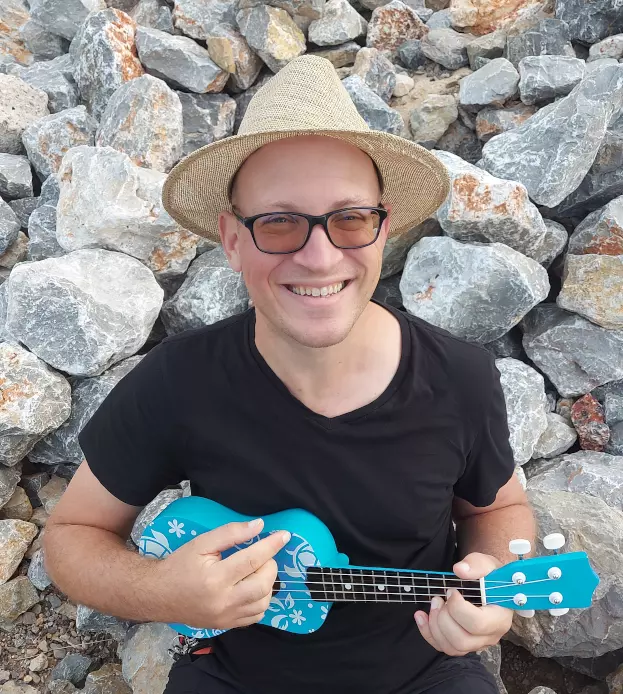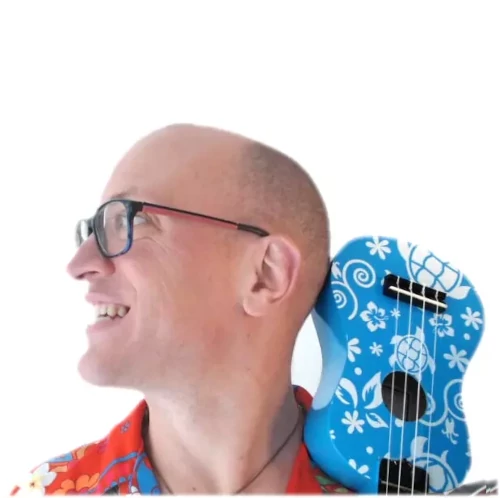
Hi, I'm Nicholas, your ukulele teacher
✨ 🎵 Learning with me is fun & relaxed!
- Patient & encouraging
- Music with a smile
- Personalized lessons
Ready to play? Let’s go!🎶🌟
Looking For Ukulele Resources & Tools? Here Are The Best Websites
Best sites for ukulele players and musicians: here you'll find really helpful sites, just for you, you lucky ukulelist!
Do you play guitar? Drums? Piano? Cello? Violon? Flute? Trumpet? Or else? I'm sure you'll find there some nuggets!
- Table of Contents
- Best site for beginner and intermediate ukulele players
- Best site to find chords and lyrics of songs
- Best site to buy a ukulele
- Best site to compose and write music
- Metronome
- About practising
- Miscellaneous

Best site for beginner and intermediate ukulele players
What are the best online ukulele (or guitar) websites for a beginner/intermediate music player?
Website to tune your instrument
How to tune a ukulele? How to tune a ukulele with a website?
Don't want to install an app to tune your instrument? No worries, you can try this site.
It's easy as pie!
UkuTabs' ukulele tuner
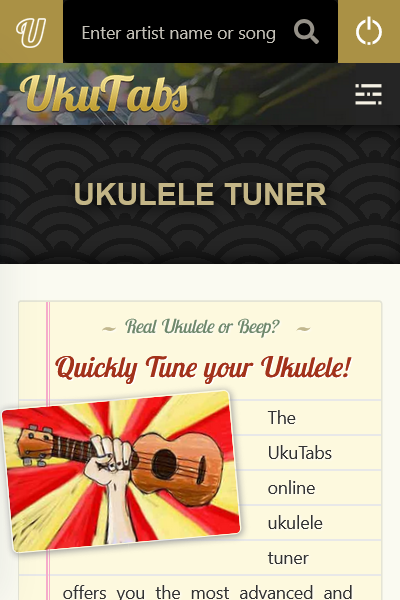
It's a simple tuner for ukulele. It's nice and accurate.
Once you are on the page, scroll down to find the tuner.
UkuTabs' ukulele tuner: ukutabs.com/ukulele-tuner
This website has more to it, so make sure to check its extensive song library.
How to use UkuTabs's tuner?
You will have to:
- press the starting button named: "Tap to start" for UkuTabs' tuner
- accept the use of your microphone
And here you go.
No need to install an app for that.
Ukulele Chords
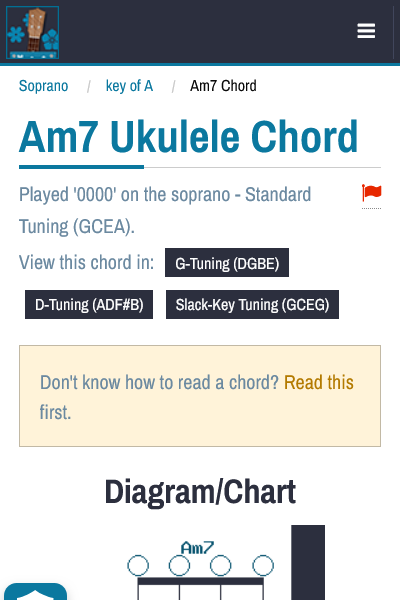
What is the best ukulele chord website?
It's a site I often visit, as there are hundreds of different chords, and about 3 voicings for each. (A voicing is another way to play the same chord, another finger placement).
I just love it. It's a great reference.
Pay attention about diagrams with a number on the side
What's the number on the side of the chord diagram?
*
Generally, the top of the chord diagram matches the top of the fretboard.
If we have a number on the side of the diagram, it means that the starting point isn't the top of the fretboard anymore. But the fret next to withch the number is placed corresponds to the nth fret on the fretboard.
In other words, when you see a number next to a fretboard diagram, it's indicating the fret number where the diagram starts.
This is especially useful when a chord shape is played higher up the neck and doesn’t start at the 1st fret.
If there is a 5 next to the diagram, the fret next to which it is placed will match the 5rd fret of the fretboard.
That "5" means the diagram starts at the 5th fret.
To play this Cadd9, you will have to press on the 5th fret of the string A.
--
Another example:
is equivalent to:
Why it matters?
On beginner chords, you often don’t see a number because it’s assumed you’re on frets 1–4.
But for more advanced chords (like a B7 or a barre shape), the diagram might begin on fret 5, 7, 9, etc., and that number tells you where to place your fingers accordingly.
Voicing of a chord
Chords could sometime be played in a different way. For instance, the G chord is played typically that way:
But it can also be played that way:
Why it matters?
Voicing of a chord: for smooth transition
Sometimes, it’s easier (and sounds better) to use a chord shape that’s closer to your previous or next chord.
If you're playing a progression like G (0232) to C (0003), that’s simple.
But if you're playing chords up the neck, you might use C as 5433 to avoid big jumps.
See more about voicing: Unlock The Power Of Ukulele Voicings and Movable Chords Today
On the Ukulele Chords site, you can find how to play one chord, but also other ways to play the same chord (voicing) when possible.
Some help with challenging chords
Last but not the least, you can check some articles about chords :
The E Chord Made Easy: 3 Simple Tricks for Beginners
How to play the D chord on the ukulele the easy way: the complete guide
How to play the G chord on the ukulele the easy way: the complete guide
Do you have other chords that you find hard to do? Or chords that aren't that easy to change to? Feel free to let me know in the comment section, and I'll do my best to help. :)
Best site to find chords and lyrics of songs
Ultimate Guitar
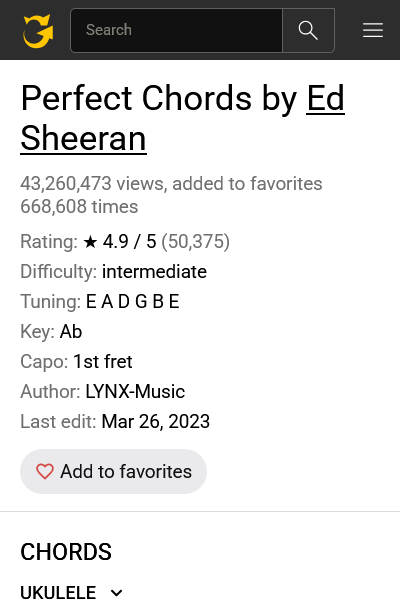
There you will find thousands of songs that you love.
The best option in my opinion is to use a search engine (DuckDuckGo, Ecosia, Bing, Google etc). Input "song you like's title and artist" and the word "chords" (for instance "Pinky and the Brain Chords"). Then go on the matching ultimate guitar page.
Tips to use Ultimate Guitar and other chord+lyrics website
Pay attention about "capo"
Is there something mentioned about "capo" plus a number? The chords of the song are not in the original key that you are familiar with.
In other words, if it is written "capo 2", all the chords are 2 semi-tones lower than the original track.
On Ultimate Guitar, you can transpose the chords to +2. On some other site, you can select a key to change your music in. See below.
Learn more about the capo and using it there: Capo On Ukulele: 5 Simple Tricks To Sound Better!
Transpose button
You can use the Transpose "-1" and "+1" at the bottom of the page on computers. Unfortunately, the mobile's website does not offer that feature.
Tonton Remy
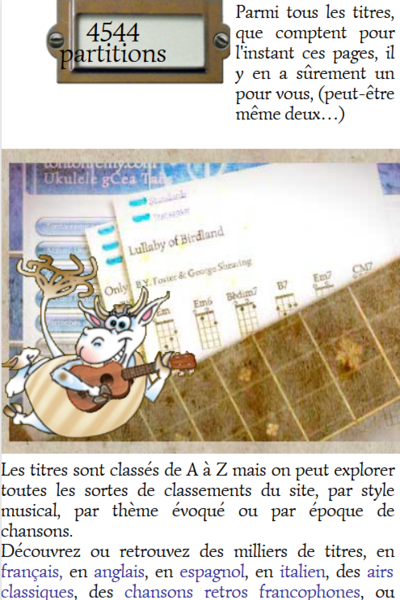
Even though this website is in French, it has numerous songs' chords in English.
You may need a bit of guessing and memories of the French lessons you have attended in secondary school. But you can find what you need there.
Best site to buy a ukulele
What are the best websites to buy a ukulele online?
Here are some ukulele makers or online music shops I like.
Don't hesitate to go to your local music dealer. It's far better getting some first-hand advice and trying several ukuleles before buying one.
Instrument maker
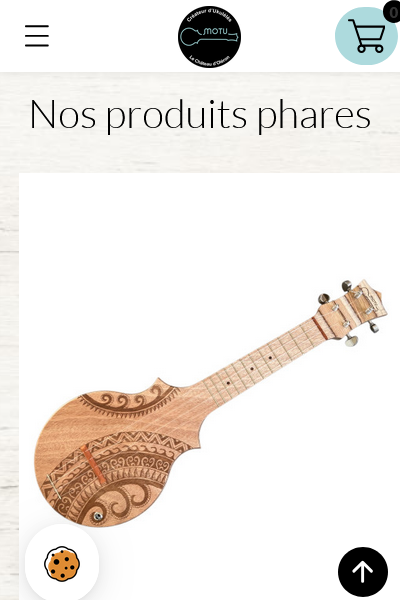
If ever you visit the beautiful Oléron Island, France (Île d'Oléron), you may want to stop at this ukulele maker shop.
They produce some stylish and thin ukuleles, with a kind of higher pitch than some others and a unique feeling.
Of course, you could also visit their online store.
La Case à Ukes | Boutique en ligne de Motu Ukulélés
Shops
Don't hesitate to go to your music dealer downtown and to check the other dealers in the surrounding cities.
The best thing is to try and hear for yourself, and get some tips from a seller.
Also, nowadays, many shops from big cities have e-commerce websites. You can search by yourself if you want.
Other than that, you can visit this music retailer:
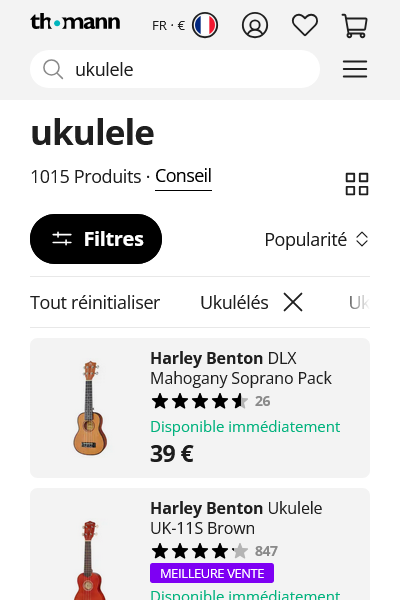 Here, you can search more information and compare prices before buying a ukulele.
Here, you can search more information and compare prices before buying a ukulele.But hearing the sound of a real uke before getting it is my sound advice.
Best site to compose and write music
What website is the best for making music with a ukulele?
What website can I use to compose my own music? Where can I make a song for free with my ukulele?
Generate Chord Progression
What'd be amazing chord progression generator for free?
Chord generator ukulele?
ChordChord (legacy): Generate Chord Progression randomly
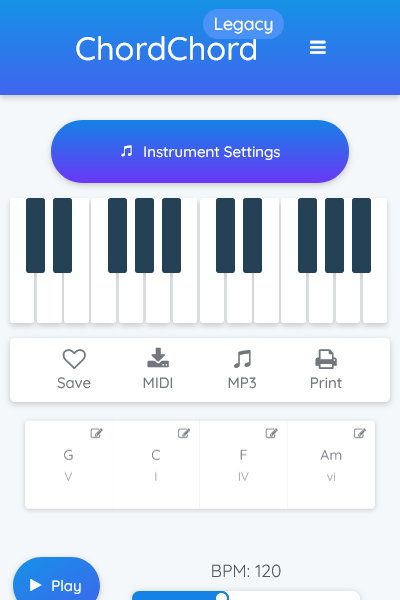
Chordchord is a fun toy that generates chord progressions to mess around.
I like spending some time trying to play the proposals from ChordChord's chord progression generator.
I just try some chord progressions.
And if I want to try a new one, I click "Generate", and it gives me a new chord progression. A new feel. A new atmosphere.
It's great to play around. Sometimes, you could start singing what's on your heart with the chord progression which it gave you.
Great for composing some new songs, right?
I prefer much better the random approach: generate a new chord progression until you find something interesting. You'll get surprised by it!
New ChordChord: use AI to generate chord progression
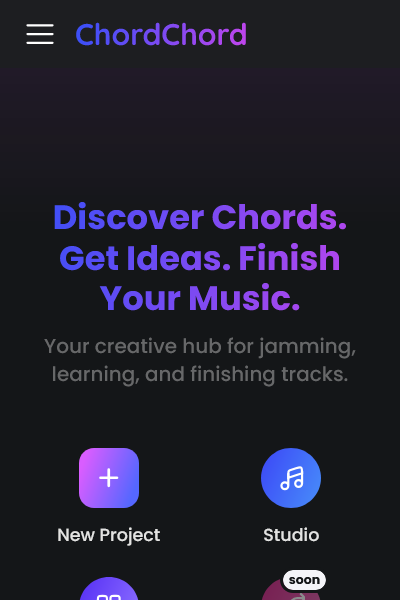
ChordChord have created a new chord progression generator. Its advantage: it uses AI.
You have to write a description of what you want in the input box. Then click "Generate".
Like: "a nice cheerful fast tune please" (note that the word "Please" is optional).
I generally delete the generated drums, because it doesn't sound good at all with drums.
However, if you are in a specific mood, then describe it in the input box and click "Generate".
Like "I'm kind of sad, please give me a tune" (but I hope you don't feel sad, though).
Maybe you have written some lyrics and want some music that matches their tone? Maybe you'd like to describe what kind of feel you want? Or maybe you just want to input your song title and some of the lyrics of your song?
Once you've done it, click on "Generate".
Et Voilà
Musicca's Chord Player: a simple chord generator
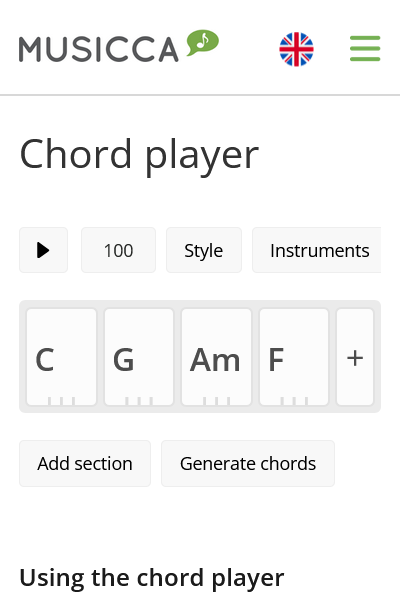
Here is another chord progression generator. Simple, no fuss, yet efficient. Have fun!
Chord progression generator: musicca.com/chord-player
Generate lyrics
You can simply use ChatGPT to write lyrics.
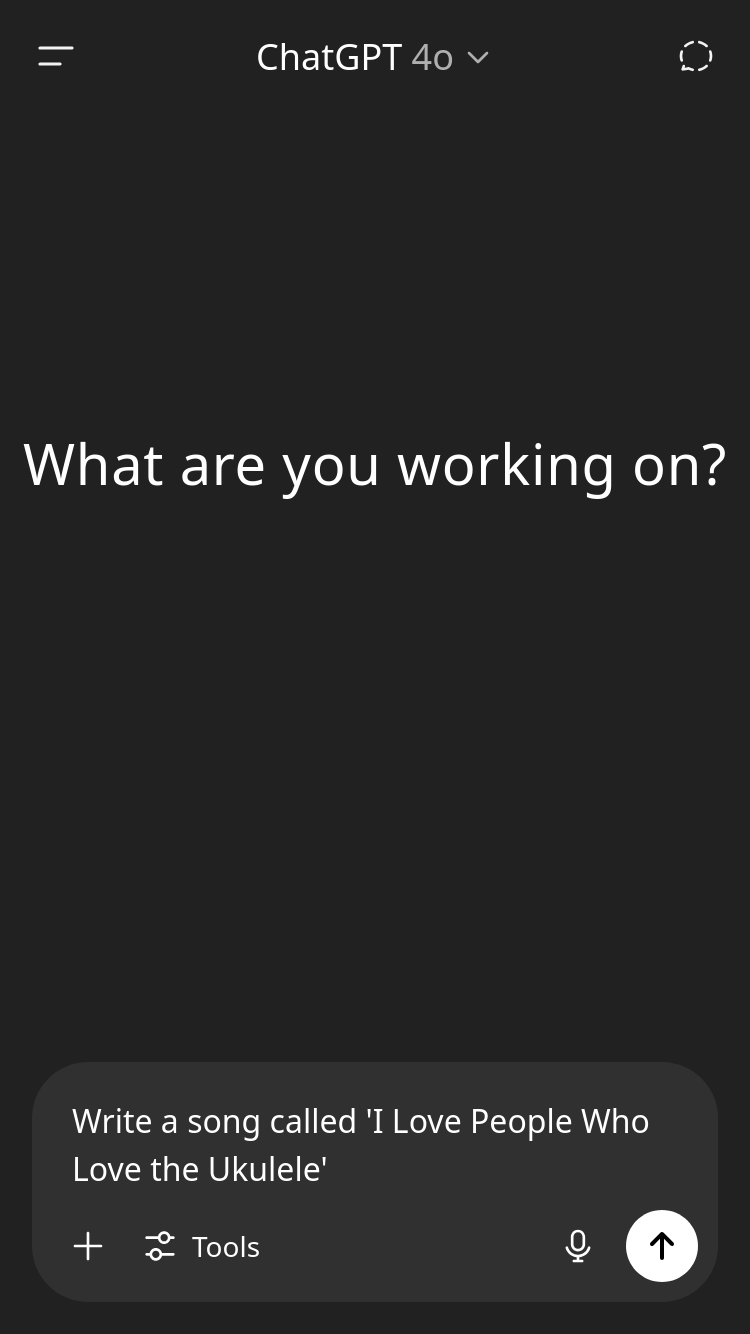
Prompt example: "Please write the lyrics of a song about the irony of being late."
Simple Littl’ Metronome :
A very handy metronom for mobile phone & computer.
Metronome
A great yet simple metronome
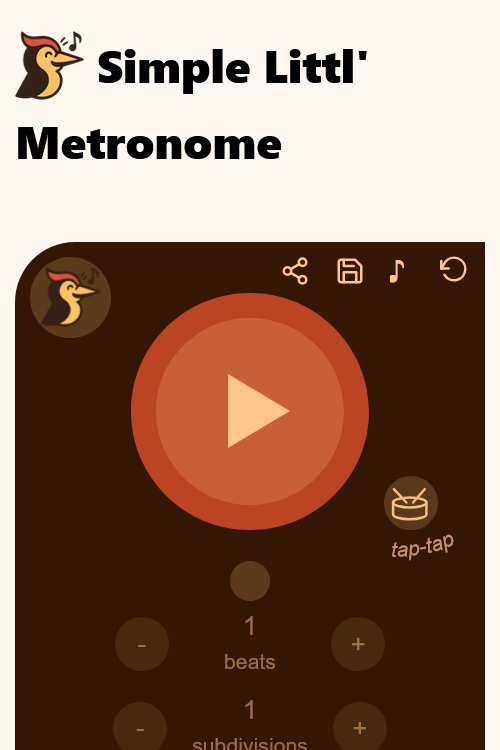
I'm doing my best so that you find on this website:
- some great tips to improve;
- some great articles to help you on your journey;
- and some great tools.
Here is a simple metronome that you can use on your computer or on your website. Let me know how I can improve it. :-)
Why is it great?
- It's simple, with a clear yet nice design.
- You can share your tempo easily, with the "Share" button.
- You can have subdivisions, to hear off-beats.
- You can save your tempo and rename it, so that you can have a tempo for each of your music or exercise.
- You can tap to find out what tempo you're hearing - great to find out what tempo you are listening to - and it syncs the metronom directly.
Tips
A metronome is an efficient way to practise. It's also fun, if you use it correctly.
But at first, it's hard.
Tips: start slowIf you have never used a metronome, try to put it at 60.
Then play one strum for every beat.
Once you get used to it, try two strums every beat.
Then get a faster temp, like 65. Then try 70. 80. 90. 100. You get it.
Tips: start slow alwaysIf you have already used a metronome, keep in mind that it's great to start a little slower than the tempo you plan to play the music track or exercise.
Why a metronome?
After you've tried for a while to do a part of a music or a exercise, using the metronome will bring a ludic and fun new way to train.
One of my use cases is that I work on speeding up a passage. So let's say I start at 80 BPM and then I want to gradually up the tempo by increments of 5.
Be cool
Be cool. It's easy to get frustrated when rehearsing. But it's no use to get angry. Be cool.
Take it slow. At least slower. And you'll get there.
Using a metronome could be hard at first. But it's a tool that will help you on your way.
An accelerating metronome to help you practise
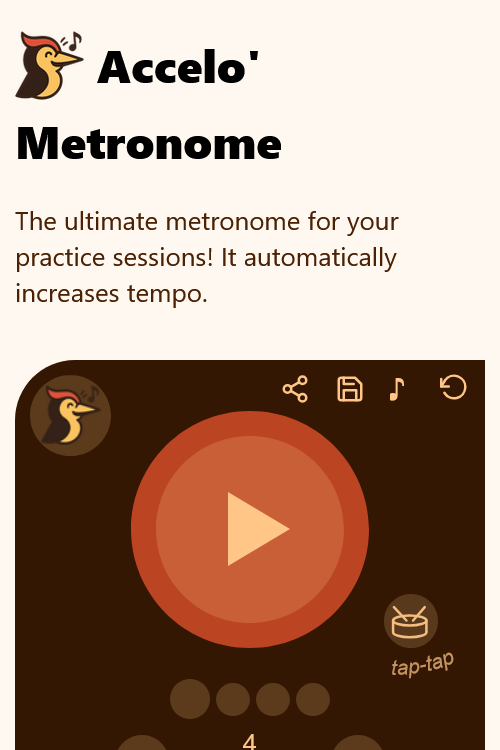
Anddddd last but not the least = epic drumrolls = here comes...
This tool does exactly what it says on the tin.
It's a metronome, but it get faster as it goes!
What the use, would you ask me.
Practising!
If you can play it slow, you can play it quickly. In other words in this context: practise a technique slowly first, then gradually play it faster.
Practice makes perfect
There are plenty of metronome available online, or as apps.
However, this one is especially interesting to practise chord changes or a new technique you want to master.
Starting slowly, it goes faster and faster as it goes.
That way, you can try practising slowly, many many times, as you will get quicker as you go.
"Best metronome for your practice sessions. Support for odd time signatures and ability to increase tempo after every round."
Accelo' Metronome is a favourite tool to practise.
It's a wonder!
It's a wonder. Why?
- You can easily share your tempo settings. (Click the "Share" button).
- You have use subdivisions, like quavers or semi-quavers.
- You can save all the settings, either by bookmarking the page (it saves all the settings) or by using the "Save" button.
My favourite settings
My favourite settings for accelonome are as follows:
- "Starting tempo" of 60
- "Increase Tempo By" 3
- "After Every" 2 bars
- Let the default "Time Signature" to 4/4
Then you can see what's the max tempo you reach playing what you intent to practise.
Tempo of 60, increasing by 3 every 2 bars
I like to practise exercise or scale with it.
Tap Tempo
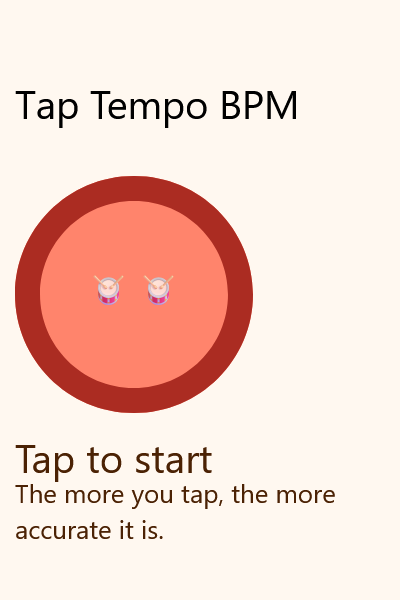
You find it in Simple Littl’ Metronome and Accelo' Metronome as well.
Tap Tempo is a super handy feature found in many metronome apps and devices. Instead of manually setting a beats-per-minute (BPM) value, you simply tap a button (or screen) in rhythm—usually four or more times—and the metronome calculates the tempo based on how fast you’re tapping.
Why It’s Great
Instant tempo setting: Just tap along to the beat in your head or the tempo of a song you're listening to, and you're ready to go.
No guessing BPMs: If you don’t know the exact tempo of a tune, Tap Tempo helps you find it effortlessly.
Great for creativity: Got a new song idea and a rhythm in mind? Tap it out and capture that groove instantly.
Use Cases for Ukulele Players
Matching a song’s tempo: If you're learning a song by ear or jamming along with a recording, Tap Tempo helps you find the right BPM to practise with a metronome.
Improvisation and songwriting: Jotting down a riff or melody? Tap Tempo helps you stay consistent when building out the rhythm section or layering parts.
Live settings: Playing with a band or other musicians? Tap Tempo lets you quickly dial in the tempo you're all feeling, especially when there’s no set BPM.
It’s one of those small features that can make a big difference in how smoothly and musically you practise.
About practising
Getting better means more pleasure. Pleasure to play music you like. Pleasure to progress. Pleasure to hear more beautiful sounds.
Getting better means more freedom. Freedom to play what you want, without level restriction.
To get better, practising is the a key.
Correct guidance and lessons could be another key that could help you get better.
Practising regularly will help you improve and get faster over time, without compromising the sound quality.
Pay attention about the sound rendering. It's the reason you should start slow each time. You will then have time to take care of the sound quality.
Beside, it's not because you can play fast one day that you can reach the same tempo the following day.
But if you practise consistently, you will be able to get better and better.
It's just awesome!
Miscellaneous
A great site specialised in ukulele
A bit of self-promotion doesn't hurt.
If you like what you're reading, maybe you could find other articles interesting. youcoolele.com
Have a look.
Feel free to drop me a message and let me know what you think, whether you love it or not.
Find the name of the chords you are playing
Ever found yourself pressing "random" notes, playing them, and the chord that comes out of it sounds great?
But then you realise that you don't know the name of this chord?
Fear not, for this site will put a name of the chord you are playing.
Find the chord you're playing according to the notes you are pressing on the frets
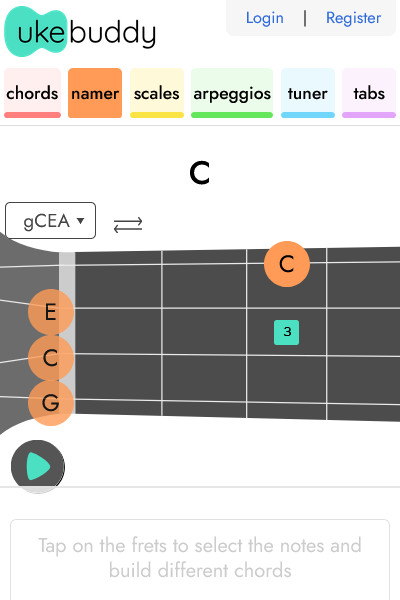
What's the name of that ukulele chord? Just select the notes of the chord on the ukulele fretboard and UkeBuddy finds the matching chord and keys.
You can then realise than four same notes on your ukulele can sometimes give more than one chord. In other words, two different chords could be played in the same fashion. Example: Am7 and C6. These two chords are played with the right hand without the left one: only open strings!
Find a song's key by its chords
You have a bunch of chords from a song. But you don't know what key this song is? Here is the website you need!
Find the key of a song according to its chords
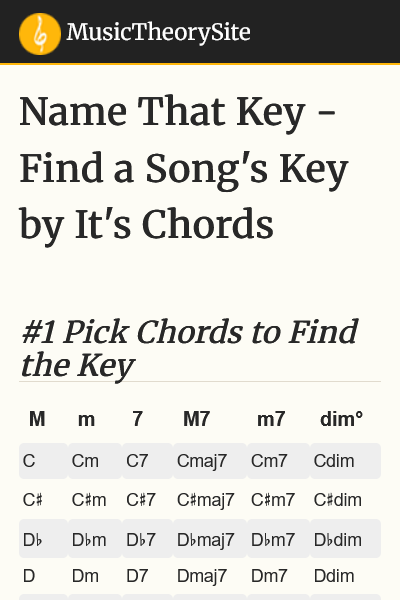
You just have to touch (or click) the keys used in the song.
The site will then give you the key it is in. Magic!
Would you like some help on a regular basis?
Why not book a lesson?
You'll have the help of an expert to progress and improve, while keeping it fun.
And you?
What are the ukulele-related sites (or apps!) that you like to use?
Feel free to let a comment below.

Hey there! Looking for a fun way to strum your way into the world of music?
Well, look no further! I'm Nicholas, your friendly ukulele teacher extraordinaire! With my expertise and a sprinkle of laughter, I'll have you strumming those strings like a pro in no time.
Get ready to unleash your inner musician and embark on a musical journey.
